Church Street Blackburn’s Premier Street
By Mike Sumner
Historical Background
Church Street is Blackburn’s oldest street and takes its name from its original church, the Church of St Marie (St. Mary), which, like the street, can be traced back over 1000 years. Nowadays, the street starts from Higher Church Street which falls from Astley Gate, at the top of King Street, down to its junction with Darwen Street and King William Street, before descending down to Salford with its junctions with Railway Road, Eanam and Ainsworth Street.
The Romans are known to have travelled from Manchester to their fort at Ribchester along roads they had laid out and used the shallow waters at the Salford end of Church Street, as a ford to cross the river, which encouraged local people to live close to this point for trade opportunities. As the original wooden timbered church was in existence in 596 AD, all the earliest buildings/homes close by on Church Street would have been very simple wooden structures. By Norman times, when the church had been replaced and later built again as a stone structure in 1350, the street was largely a huddle of small wooden cabins, each with its adjacent garden plot. By the Middle Ages, however, it had grown and assumed a more picturesque appearance, and, in Elizabethan times, there was a sprinkling of two-storied dwellings with over-hanging half-timbered gables which added to its attractiveness.
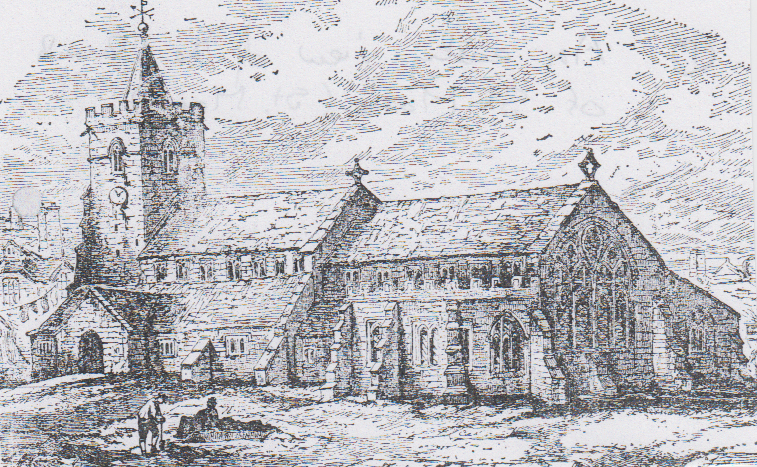
An Early View of the Church of St Marie (St. Mary)
*Further details of the parish church can be found in my Darwen Street article.
An early map of Blackburn by R. Lang in 1739 shows Salford Bridge opening directly onto Church Street (without Railway Road or Ainsworth Street). There is a single tenement depicted; possibly, the original building on the site of the White Bull Hotel whilst most of the area north of this is unenclosed. At this time, most of the resident population seems to be clustered in the vicinity of the church and around the market place, near the top of Church Street. Later, after further development on the street, a local writer of the day commented that he often looked up Church Street from Salford Bridge towards the old market place at its top end viewing the cobbled pavement thronged with dignified burghers and their dames clad in trunk hose, ruffs and farthingales.
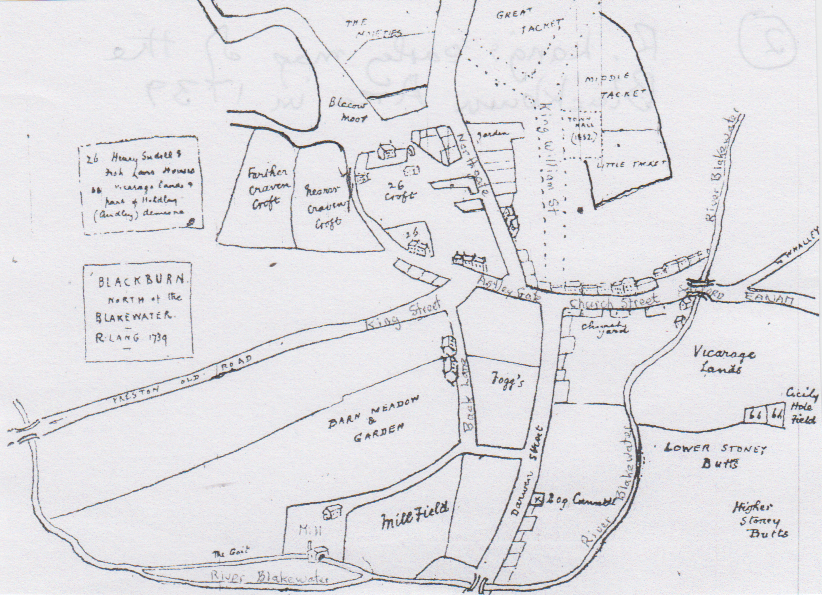
R. Lang’s early map of the Blackburn Area in 1739
The earliest link to the Tudor Period was a Town House occupied by Abbot John Paslew from Whalley Abbey who also served as the Vicar of Blackburn’s Parish Church when it was under the rule of Whalley Abbey. The house was situated on the north side of the Street where Thwaites Arcade was built in 1882. During the Abbots trial at Lancaster, on a charge of high treason, it was stated that his house had been ransacked by the Earl of Essex and a treasonable letter discovered, hidden in a secret place, from the Duke of Norfolk to Lord D’Arcy; this sealed the Abbot's fate and led to him being hanged (in 1537). This fine old mansion had formerly two over-hanging half-timbered gables decorated with “magpie timber-work"; the upper windows were divided by stone mullions and transoms, and, retained their original glass until the building's end. Luke Walmsley, who later occupied the premises, as an art dealer, described the inside the building as being rambling and quaint with domestic gothic type windows and stone mullions and old glass panes proudly glowing in goblin like squints from a huge bull's-eye. The floor was a bit shaky and hollow here and there. Originally, the building was entered by several stone steps from the street but later the shop front was lowered to street level. The house was two made up of two storeys and had a cellar and, later, during the 18th Century, two bow windows were added, flanking the entrance. In 1824, it was recorded as 14, Church Street, and one half was tenanted by Thomas Rogerson, a printer and book-seller, and, the other portion, by a widow called Elizabeth Cross, a post-mistress and draper. The building was used when the abbot visited Blackburn and the Church of St. Mary. At this time, there were three mails into Blackburn, namely one from Clitheroe, Skipton, Burnley, Colne and Yorkshire; a second from Preston, Lancaster, Carlisle and the North, and finally, one from Manchester and the South. The mail was transported by coach and had to be delivered and collected by hand to the Post Office. By 1840, when the penny postage stamp was introduced by Rowland Hill, the postmaster was Thomas Butterfield, who operated from a private house on King Street and letters between Blackburn and Preston were conveyed by a “foot post” which operated from 1831; the best known operator was William Holland who carried bags of mail between the two towns for eleven years, prior to the introduction of a mail cart.
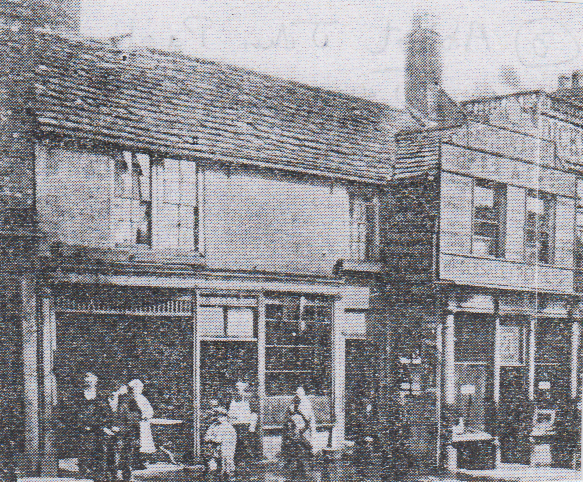
Abbot John Paslew's Town House in 1870
Immediately below John Paslew’s mansion was another ancient mansion, namely, the old manor house of the Feilden’s. The front entrance to this house faced west, at right- angles to the street and opened out onto a sort of courtyard, or, grassy forecourt, its boundary marked by a row of wooden posts linked by chains curving towards the churchyard steps from Church Street. At this time, the buildings on both side of the street extended out, narrowing the thoroughfare, which became a bottleneck to horse drawn carriages/carts. There was a date-stone above the entrance porch to the mansion which read H.E.F. (Henry and Elizabeth Feilden) 1728; this date must commemorate some later re-building for the original structure was much older. The Feildens’ first became joint Lords of Blackburn Manor in 1721, and, the family left the premises in 1880 for their new Witton Estate. When the family left the building, it was converted into no fewer than four separate shop premises with the portion nearest the churchyard steps being taken by Samuel Slater a chair-maker. He was a reformer and his home soon acquired the nickname “Radical Corner”. Later, most of the premises were occupied by Dickinson and Nuttall Furnishing Drapers who occupied it for about 150 years until it was demolished for Thwaites Arcade.
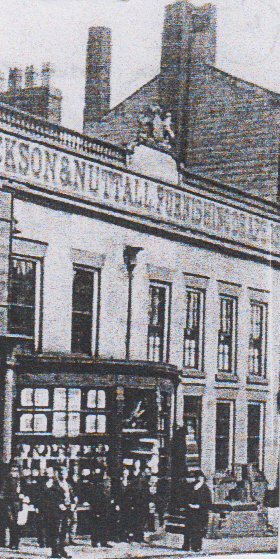
The Manor House of the Feilden Family
At the top of Church Street and it’s junction with Darwen Street, facing where the old market place was situated, was the site of the Old Bull Hotel, a low half-timbered thatched-roofed building with wide gables and mullioned windows and an arched entrance to its courtyard from Darwen Street. In 1847, the old building was demolished and a new commercial house of three storeys became the new Old Bull Hotel with two entrances. The merchants from both Blackburn and other local towns assembled there for the transaction of business every market day of each week. It was a coaching inn, and, in 1840, the landlord was Edward Sansom, who with James Bland, ran coaches to Bolton, Manchester, Liverpool, London and all places south, as well as coaches to Preston, Blackpool, Lancaster, Carlisle, Glasgow and all places north.
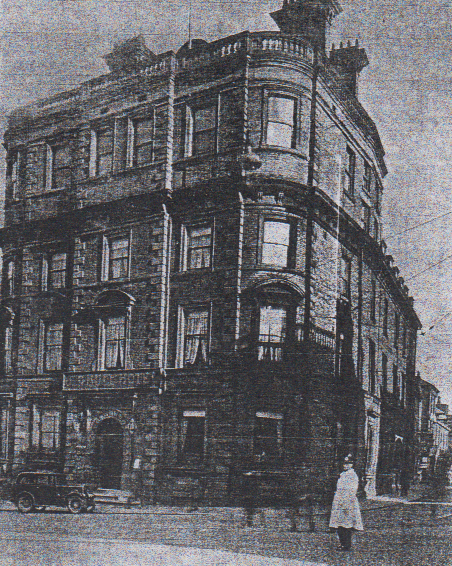
The Newer version of the Old Bull Hotel
*Please note that details of the Old Market Place and further details on the Old Bull Hotel can also be found in my article on Darwen Street on Cotton Town.
As recently as 1833, there was a public whipping in the Old Market place when a local weaver was punished for stealing weft from his employer which was a recurrent problem. As a result, the local magistrates, most of whom, were cotton manufacturers with a vested interest, decided on this drastic measure as a warning. The man was tied to the back of a four-wheeled chaise and an official from Preston Gaol administered the punishment.
Nine stone buildings known as the Waterloo Buildings or "Pavilions"were sited on the upper church side of Church Street. The Waterloo buildings were built in 1835 of stone from Catlow Quarry, near Burnley, and were made up of five double and four single shops, leaving an opening through which the parish church could be seen.
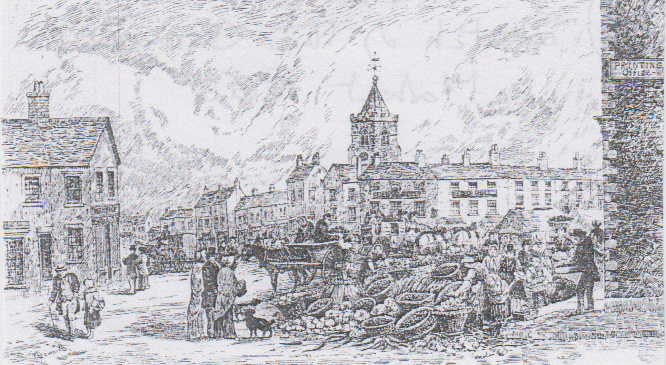 Sketch of the original Market Place
Sketch of the original Market Place
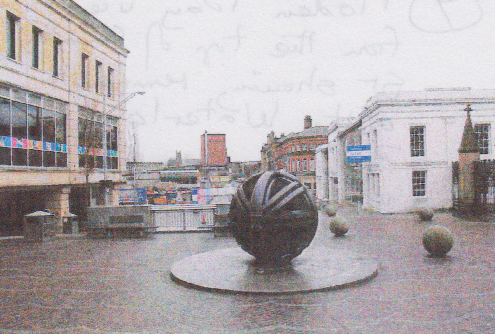
Modern day view from the top of Church street showing remnants of the
Waterloo Buildings painted white and modernized on the right of the picture
Another ancient, three-storied house, on the opposite side of Church Street to the Waterloo Buildings was the town house of the Sudell family. The brick frontage of the original Jacobean house shown in the illustration below is of considerable age. The upper windows with their slanted brickwork in the window-heads is typical of houses built in the 1700 to 1750 period, probably 1725-1730. The ground-floor had been altered when it was later transformed into shops. Mr. John Sudell, lived there with his sons, one of whom became joint Lord of Blackburn with Henry Feilden; he did not keep a shop as he was a Chapman who received spun cotton which he had put out to local hand-loom weavers who produced fabric for him to sell. In its time, the street-floor would have been offices, a warehouse for textile goods and living rooms. It is possible that the original structure would have been of stone, gabled towards the street and that John Sudell sometime after buying the property put in the brick front of the house as shown in the illustration below. The building was later demolished to make way for more modern Victorian Buildings/shops.
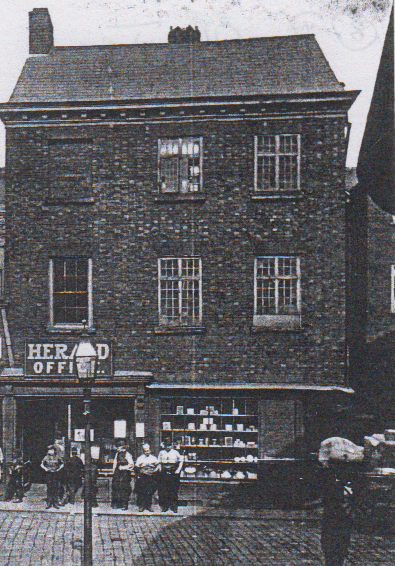
The Old Town House of the Sudell Family
Tenants Living in Property in Church Street in 1824
*The properties are numbered consecutively from lower to upper Church Street.
- William Earl – Tailor.
- Yates – Brazier.
- William Houlker – Cabinet Maker.
- James Houlker – Earthenware, Glass and China Dealer.
- Margaret Addison – Confectioner.
- Robert Brooks – Draper and Hatter.
- Alice Watson – Draper and Glover.
- William Hargreaves – Fruiterer and Fishmonger.
- John Farnworth – Hairdresser and Register Office.
- WIilliam Stackhouse – Silk Mercer.
- George and Thomas Brennand – Drapers and Isabella Brennand – Milliner.
- Thomas Rogerson – Printer, Bookseller and Publisher – Manchester Almanack.
- Elizabeth Cross – Post Office, Draper and Glover.
- Taylor Simpson – Earthenware, Glass and China Dealer.
- William Clarke – Bookseller and Binder.
- John Lewis – Grocer and Tea Dealer.
- John Jackson - Fruiterer.
- Jonathan Pinckner – Butcher.
- Thomas Edge – Painter and Gilder.
- Henry Sharples – Dyer.
- Benjamin Hall – Tailor.
- Robert Latham – Grocer and Tea Dealer.
- William and Thomas Hart – Rope Makers.
- Joseph Duxbury – Landlord of the Golden Lion Hotel.
- J.W. Astley – Bookseller and Binder.
- John Martin – Staymaker.
- John McKean – Brazier.
- Susanna Brown – Millner.
- John Aspinall – Gentleman and William Aspinall – Attorney.
- Thomas Dugdale – Surgeon.
- Henry Stanley & Co. – Wine and Spirit Merchants.
- William Greenwood – Landlord of White Bull Hotel and Martha Hudson – Butcher.
- Elizabeth Melling – Milliner.
- Thomas Melling – Collector of Church Rates.
- James Ainsworth – Tailor.
- Elizabeth Ingram – Milliner.
- Ann Royle – Shopkeeper.
- George Jackson – Tallow Chandler.
- Joseph Makinson – Attorney.
- James Butcher – Ironmonger, Whitesmith and Bellhanger.
- Peter Atkin – Wholesale Draper and Alice Atkin – Silk Mercer.
- Thomas Pomfret – Brazier.
- James Haworth – Draper and Mary Wilson – Earthenware, Glass and China Dealer.
- Joseph Pomfret – Hozier.
- John Badger – Draper and Mary Badger – Milliner.
- A.J. Yeadon – Straw Hat Manufacturer.
- Robert Holgate Sagar – Watch and Clock Maker - B.F.Allen & Co –Corn/Flour Dealers.
- Robert Yearsley – Landlord Old Bull Hotel and Posting House.
- John Lewis – Grocer and Tea Dealer.
- Robert Coxon – Pork Butcher.
- Ellen Worthington – Draper and Tea Dealer. – Sarah Boardman – Haberdasher.
- H. Alderson & Co. – Tea Dealer.
- Thomas Duckworth – Landlord of Lower Sun Inn and Plumber and Glazier.
- Constant Whiteacre – Baby Linen repository.
- Mary Sharples – Landlord of Higher Sun Inn.
Church Street Sites from it’s Current Source at Astley Gate Down
to it’s Juction with the Salford Area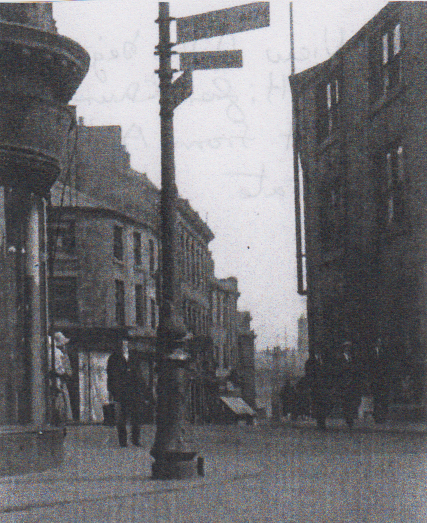 View of the beginning of Higher Church Street from Astley Gate
View of the beginning of Higher Church Street from Astley Gate
The Higher Sun Inn; 61, Higher Church Street –This Inn was a popular hostelry towards the end of the 18th century when its landlord was John Baker who died in 1795. John was followed by Thomas Sharples, who came from the Milk House Farm in Shire Brow; Thomas died in 1824, aged 81 years, when he held the distinction of being the oldest landlord in the town. In 1827, the landlord was Mrs. Mary Sharples and had stables, a laundry and a dwelling house with a shop adjoining. John Sagar became the tenant in 1851.
The Lower Sun Inn; 59, Higher Church Street – This was sited just below the Higher Sun Inn, and, prior to 1793, its landlord was Mr. John Hilton. He was followed by Mr. Ralph Hartley who died in 1798. The next landlord was Mr. Snape, who, died in 1802, followed by the Duckworth family till the late 1820s/'30s.
55, Higher Church Street – This site was an umbrella business run by the Cowburn family from 1854, then, as a confectioners run by Mr. Carlisle. The property subsequently became a newsagents and stationers, first run by Mr. J. Marginson then by Mr. A Astley.
11, Higher Church Street – This was built by Mr. Henry Sudell, a Textile Manufacturer, when he got married. The Feilden family of the Witton Park Estate aquired the property in 1922 and rented out it’s rooms to one of Blackburn’s oldest clubs “The Union Club”. This club was first started in the 1840s using rented rooms in the King Street Hotel, which, in more recent times, became the Labour Exchange. * For more information on the Reform Club see my article on it in the Cotton Town Website.
Former home of Mr. Henry Sudell, 11 Higher Church Street
4, Higher Church Street – in 1851, this was the establishment of J.N.Haworth, general stationer and printer, and also, the local depot of “The London Religious Tract Society”. Mr. Haworth also held the contract for printing materials for the London and Yorkshire Railway Company and other large public bodies. It later became Pickering’s confectioners.
Dewhurst’s Great Clothing Stores; Higher Church Street – In 1883 Mr. Dewhurst acquired three large shops on Higher Church Street opposite the Union Club. These shops were converted into a fine spacious establishment with an imposing stone frontage of 62 feet graced by granite pillars with a handsome central entrance. The large left window was used to display ready-made men’s and youth's clothing whilst the right hand window was used to display a wide range of bespoke boy’s clothing which was the speciality of the business. On the second and third floors were large work-rooms where qualified labour was employed. On the lower floor, there were numerous staff attendants, and, as a large cash buyer, selling by the same terms, he could offer good deals. Architecturally, Mr. Dewhurst’s establishment was regarded as one of Blackburn’s most attractive. It was noted that during one of Blackburn’s periods of distress as a result of a downfall in the cotton industry he gave liberal distributions of bread and soup to the poor.
Old Bank (Lloyds); Corner Of Higher Church Street And Darwen Street – This bank was built in 1870, as a large stone edifice, with an ornate entrance of beautifully shaped stone and wrought iron work; it was operated by Messrs. Cunliffes, Brooks and Co. before being taken over by Lloyds Bank, who still operate from the premises. Originally, it was situated in the dead centre of the old town and was well placed across from the Old Bull Hotel which many business people used as a meeting place. The building had an unusual honeycomb design on its facing stones, the work of local sculptor Thomas Allen.
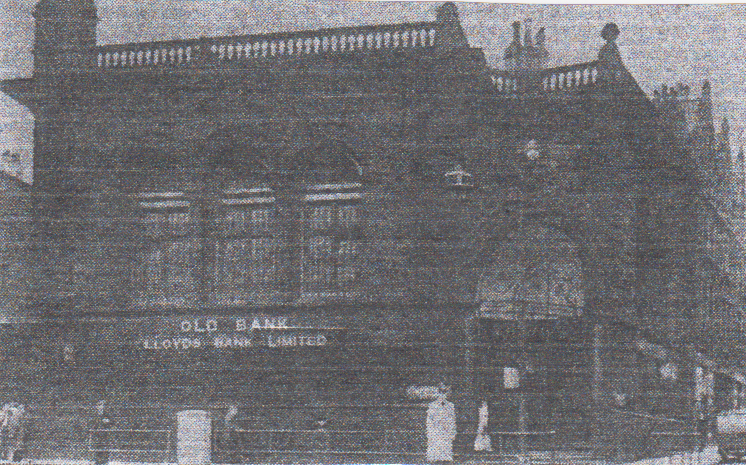
The Old Bank (Lloyds), 1 Darwen Street
The original market place used to be situated between the Old Bull Hotel and Old Bank, at the junction of Higher Church Street and Darwen Street; Full details of this can be found in my Darwen Street article on the Cotton Town Web site.
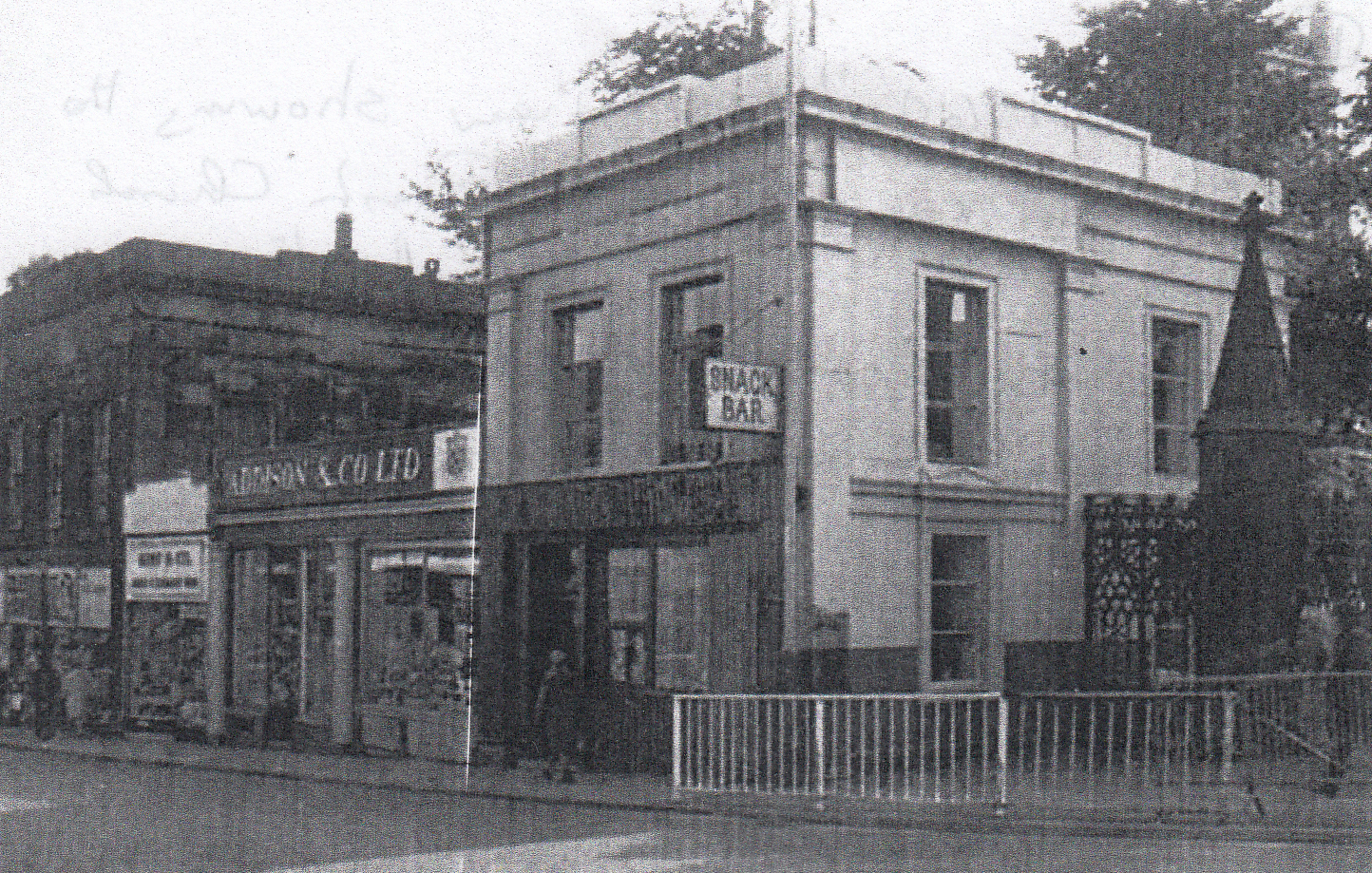
This 1960s/'70s view shows the top entrance to the parish church and belowthis is the Palatine Snack Bar and Addison & Co Ltd, Wine and Spirit Merchants
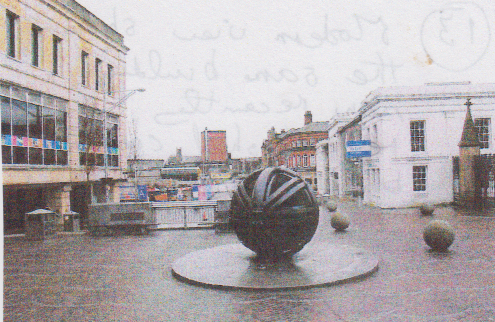
Modern View showing the same buildings now recently refurbished connected by a glass frontage
The Top End of Church Street to its Junction with King William Street
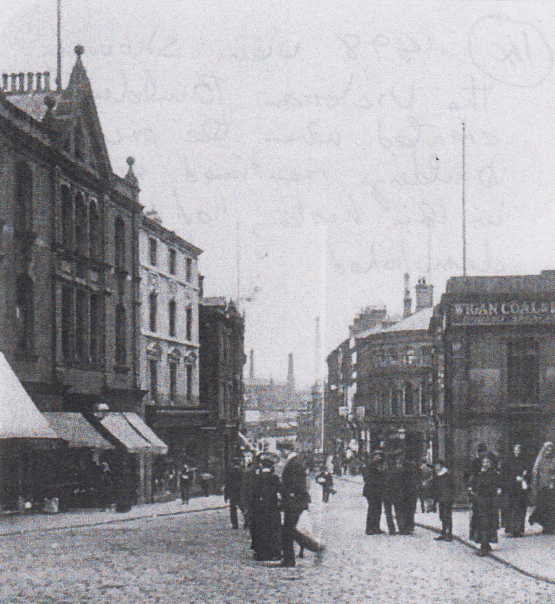
1898 View showing the Victorian Buildings created when the original buildings
mentioned earlier in this history had been demolished. Mostly three storey with high chimneys and more uniformity
with their awnings out over the shop's windows created at ground level.
Opposite is the Wigan Coal & Iron Company in the lowest of the Waterloo Buildings
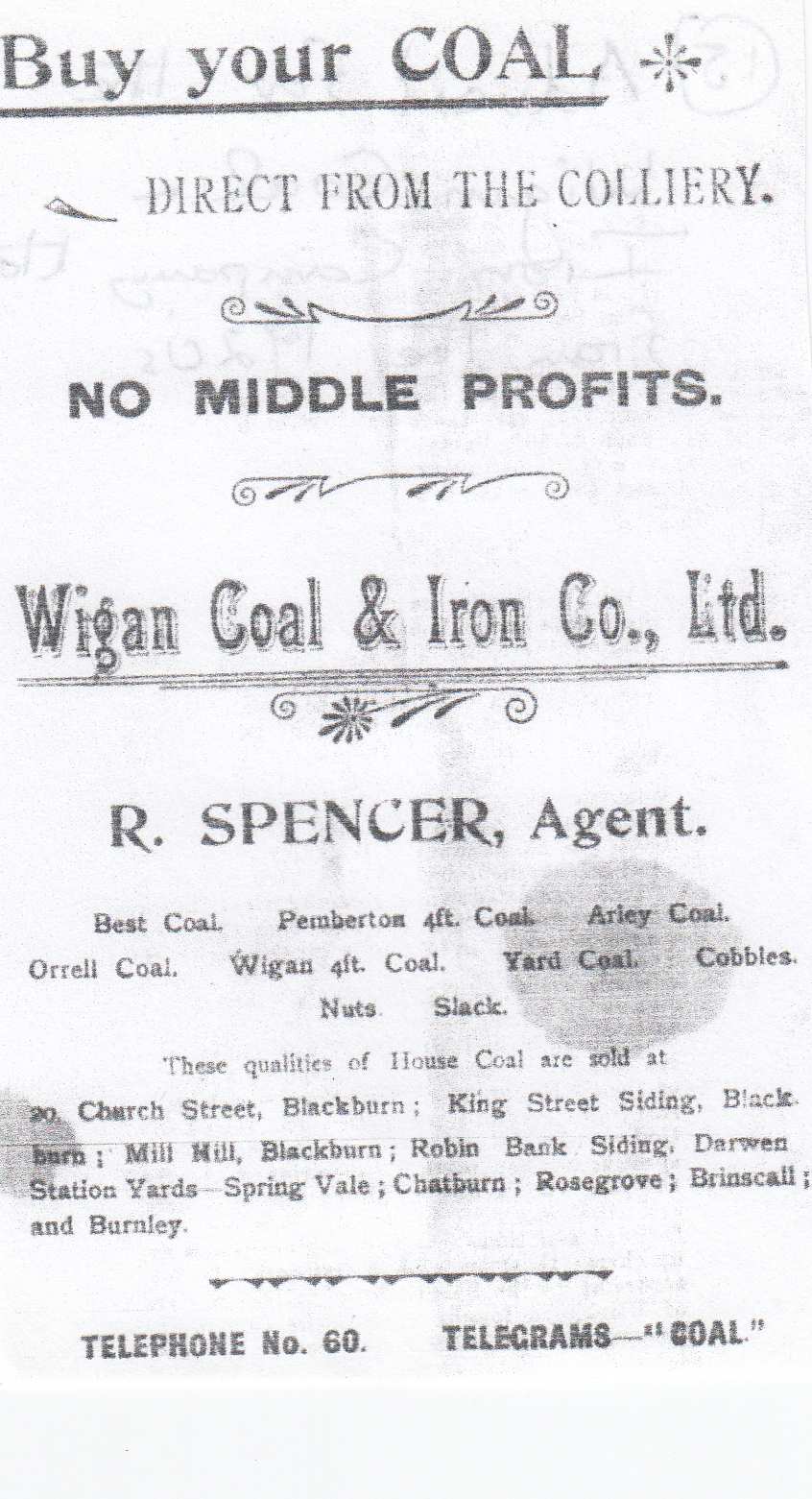 Advert for the Wigan Coal and Iron Company Ltd from the 1920s
Advert for the Wigan Coal and Iron Company Ltd from the 1920s
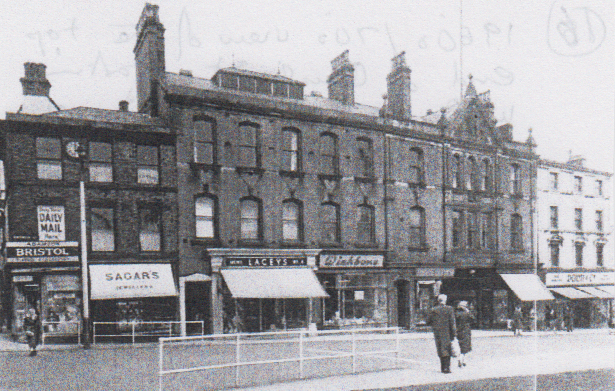 1960s/'70s view of the top end of Church Street starting with the newsagents on the corner of King William Street and Church Street. Below this, is Sagar’s a long established Jewellery Business followed by Lacey’s a clothing outfitters and originally a hatters, then Wishbone and another business before Thwaites Arcade
1960s/'70s view of the top end of Church Street starting with the newsagents on the corner of King William Street and Church Street. Below this, is Sagar’s a long established Jewellery Business followed by Lacey’s a clothing outfitters and originally a hatters, then Wishbone and another business before Thwaites Arcade.
Thwaites Arcade Church Street:
The Arcade was erected on the site of some ancient buildings already mentioned in the earlier part of this article. The Arcade linked Church Street with Lord Street and was built in 1883, after demolition of the older property on the site, and, opened in 1884. It was constructed by the Blackburn Brewer and the town's one-time Member of Parliament, Daniel Thwaites, and, had a date stone at either end of the arcade, together with the Thwaites coat-of-arms. The Arcade accommodated 22 shops, and, an additional two, flanking each entrance, where, there was ornate lamps, and, it had a high vaulted glass roof to give plenty of illumination. The shop fronts in the arcade had large glass windows that almost reached the floor. At either end of the arcade, above the entrances, were rooms extending in from the entrance, each of which, were at one time, rented out to two different political parties, namely, the Liberals and the Whigs. The Arcade was demolished in July 1971; 38 premises in the area bounded by Lord Street, Church Street, King William Street as well as the Victoria Street building, namely, Littlewoods Store, were toppled to make way for the third phase of Blackburn’s new shopping precinct. Some of the well- known shops in the Arcade included Worswick’s Jewellers, Timothy White’s Chemist, Porritt’s drapers and haberdashers and Hornby’s shoe shop.
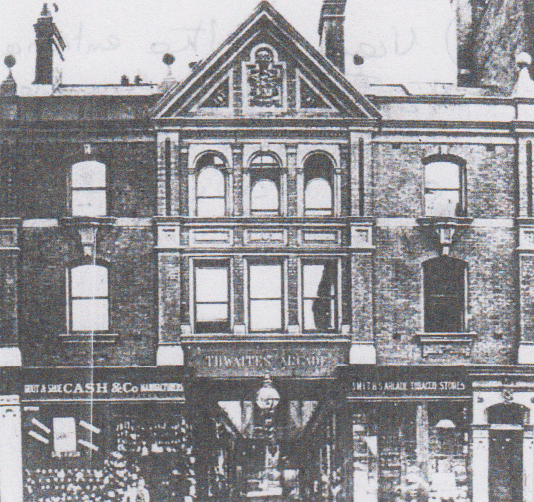
View of the entrance to Thwaites Arcade from Lord Street, early 1900s
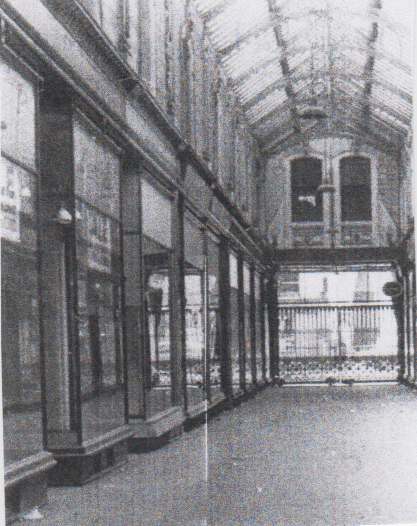
Internal view of Thwaites Arcade showing the shop fronts
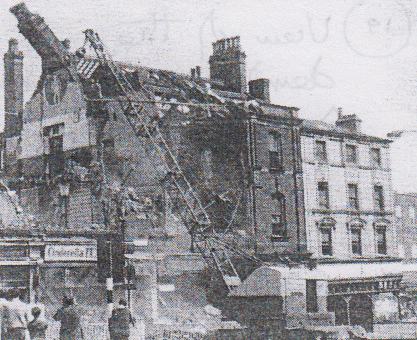
View of the demolition of Thwaites Arcade in July 1971
Shorrock Fold;
This much-used passage and remnant of Old Blackburn, leading from Church Street to Lord Street and the Market Square (formerly old Haworth Square) which led to the Tacketts (fields), was sited below Thwaites Arcade .
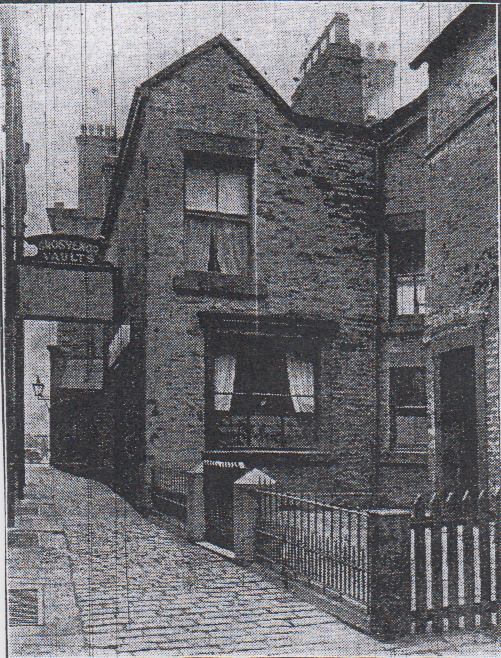
A 1920s view of Shorrock Fold showing a secluded residential house on the right of some considerable age and still occupied
This property was formerly the home of the Sexton from the Parish Church, and, one of his duties was to ring the church bell whenever a fire broke out. The passage was very important before Thwaites Arcade was built as a link to Lord Street; property on it was well kept by their occupants. At one time, there were two houses, in front of which, were fairly large gardens but one house was demolished to enable extensions to be made to the rear of the Grosvenor Hotel, shown in the above view which fronted Lord Street. Two coroners had their headquarters in Shorrock Fold, namely John Hargreaves, and, his son, Henry Unsworth Hargreaves. On the same site there was an old licensed house known as the Star Inn which was demolished when the Arcade was completed. This inn dated back to the late 18th century, and, in the early 19th century, the landlord was Mr. Adam Hall who died there in 1816. He was also the Town Constable and the town’ lock-up was a room in the inn known as the “Star Room”. Eventually, the lock-up was moved to the Higher Sun Inn, and, then to a cellar under St. Paul’s Tavern. The move followed the suicide of a man called John Roscoe in the “Star Room” when, in a state of insanity, hung himself from a hook behind the door using his black silk neckerchief. At his inquest, it was pronounced that the room was quite unfit for purpose due to its insanitary unventilated state and its insecurity. Clearly the room was provided by the Town Constable, at his own expense, and although illegal, sometimes made its occupant pay a small amount towards the rent of it! There was a second inn on Shorrock Fold, the Black Lion, which became a singing-room with its leading light being the local poet, John Charlton.
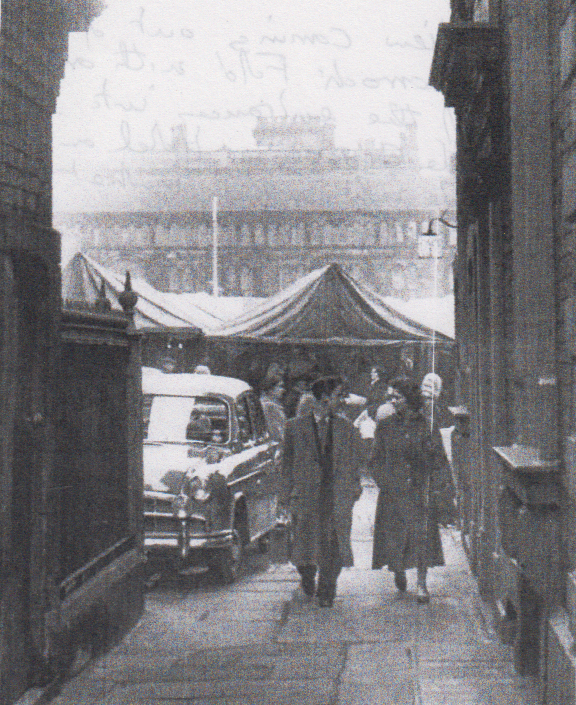
View coming out of Shorrock Fold with one of the entrances into the
Grosvenor Hotel on the right and the market square ahead
Church Street below Shorrock Fold down to Victoria Street;
A 1920s/'30s view of this middle section of Church Street with early vehicles and Victorian properties
in sight with Boydell’s clothiers and Nuttall’s Wine and Spirit
awnings in view on the left and William Deakins Bank to the right
In more recent times, the older Victorian properties were demolished to make way for newer developments, first with the Littlewoods Store; which itself was removed when a Yates’s Wine Lodge took up residency. This was a popular drinking establishment, one of 55 lodges stretching from London to Newcastle. Yates's Wine Lodges were first established in 1884, in Oldham, by Addison’s and Yates and later merged under the Yates name. Addison’s had first opened a wine lodge in Preston in 1869. Peter Yates was a supporter of the Temperance Movement and gave the firm its slogan “Moderation” which is true temperance and sold wine in preference to more lethal drinks. Alongside the alcoholic beverages, lodgers could buy Yates’s tea, soup and wholemeal flour, Yates’s El Cuervo cigars and Yates’s sardines. The lodges were run on a no frills approach in very ordinary surroundings, but, even in the 1980s; though they now sold spirits and beer, alongside wine, printed notices warned customers that if they were under the influence, they would not be served, and, at night they closed half an hour earlier than local inns/hotels. At the same time, you could only buy beer by the half pint. The Blackburn Yates’s was also known as the Dressers Arms as well as the Window Clinic and progressed to serving meals to customers. The Blackburn Yates’s was eventually demolished to make way for the now modern shopping centre.
Lowest Waterloo Building in the 1970s;This had been the home of Barclay’s Bank who occupied this Georgian building until their move to Darwen Street. In 1974, the Council asked the Department of the Environment for permission to knock it down but it was refused. Since the bank left the site it has been used occasionally by the Council for issuing old age pensioners’ concessionary bus fare passes and has since been let out to a variety of firms.
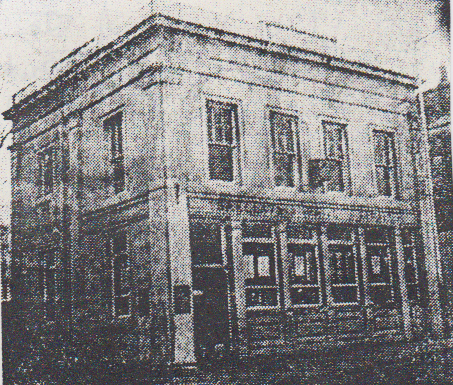
1976 view of the former Barclay Bank building in Church Street
Views of Church Street from the White Bull Hotel to Waterloo Buildings;
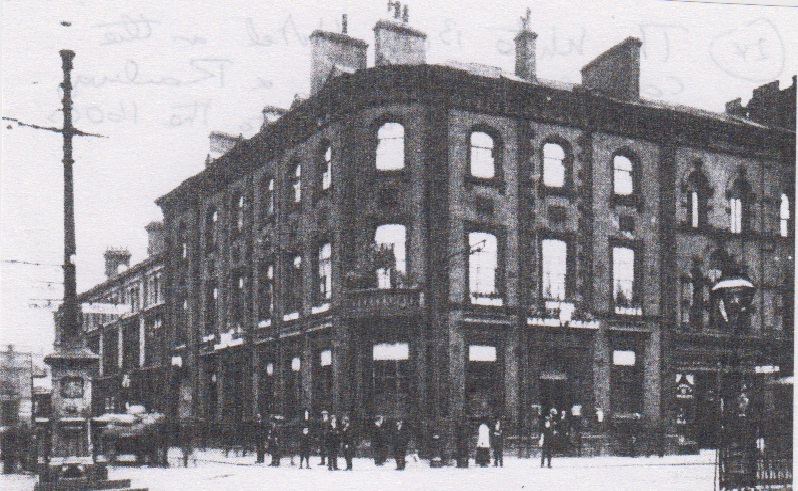
The White Bull Hotel on the corner of Church Street and Railway Road dates back to the 1600s
In the early 18th Century, the R. Lang's map of 1739, shows it detached and isolated. Before it was rebuilt in 1852, its fabric was a Jacobean structure of some distinction with half- timbered gables facing the highway and hooded mullion windows deeply recessed. At this period, the River Blakewater, before it was covered over and altered, ran round the back of the White Bull, to a spot where there was a wooden bridge, before proceeding along the side of the boulevard that was built later. It was replaced with a large Victorian building with coaching facilities; providing ample accommodation for larger numbers, being well placed close to the railway station. It had a large imposing entrance looking out to lower Church Street/Salford and the large fountain and lamp that was in the centre of the thoroughfare. The hotel had many large chimneys, covered three floors and has survived to today, although now used as a Bookmakers.
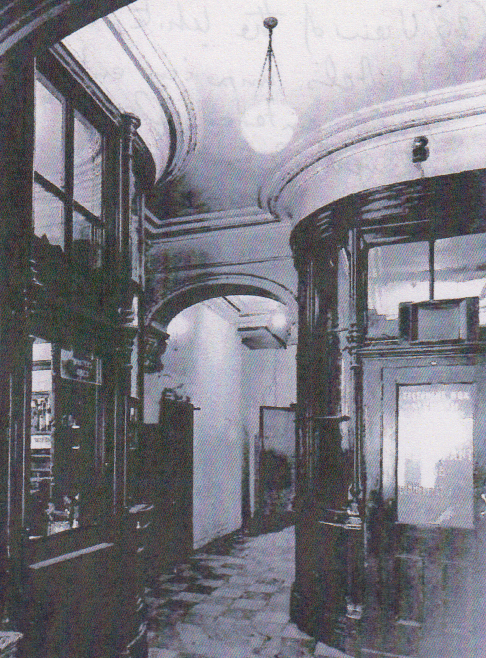
View of the White Bull Hotel’s imposing entrance hall entered from Church Street
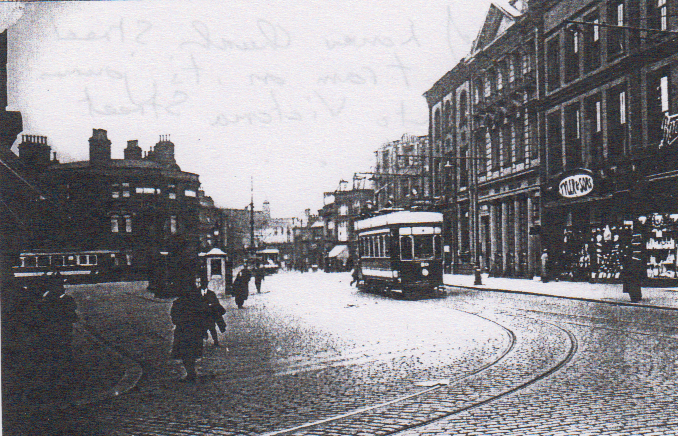
View of Lower Church Street with a tram on its journey round into Victoria Street
with a row of Victorian buildings starting with the White Bull, then the Midland Bank, Tyler and Sons
displaying their goods and Boots the chemists probably taken in the 1920s.
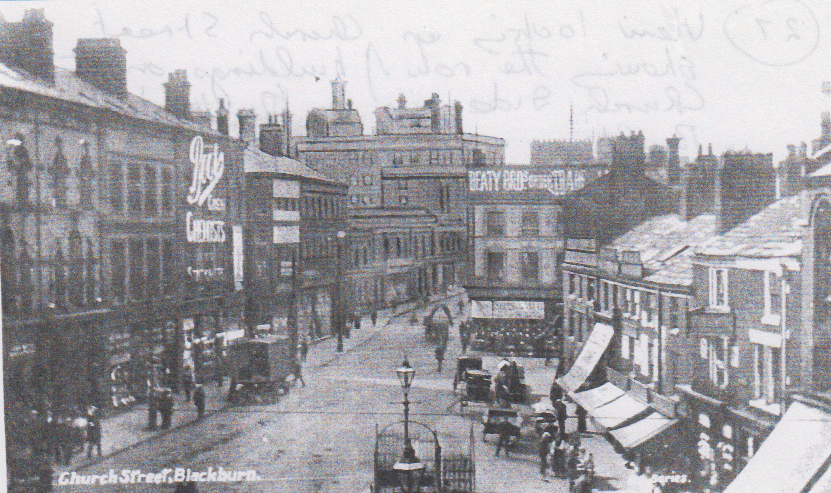
View looking up Church Street showing the row of buildings on the Church side up to the Waterloo Buildings
Church Street from Victoria Street to Ainsworth Street;
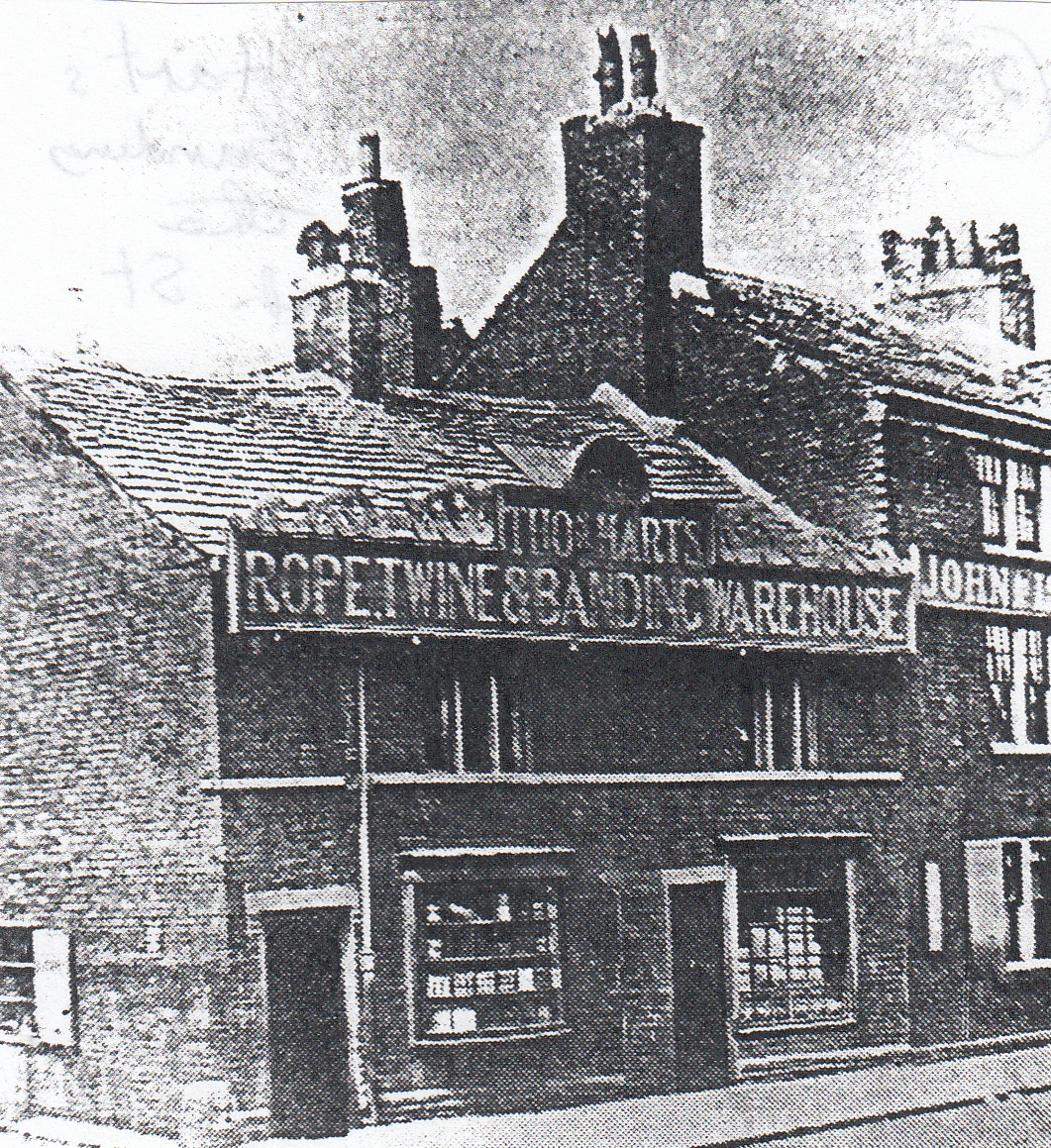
View of Thomas Hart’s Rope, Twine and Banding Warehouse on the corner of Church Street and Victoria Street
Thomas Hart was born in Leyland in 1750 and started business in Blackburn, in 1789, as a roper, on fields beyond the River Blakewater, close to the site of St. John’s Church, which was in the course of being constructed. He married Martha Almond, and, when he died suddenly, in 1802, she was left with three children but managed to bring them up and run the family business. The house and business, shown above, existed unaltered till 1874, and, was held on a yearly lease from its owner, Henry Sudell, on what was then Ainsworth Street, until it was widened to create Victoria Street, and, a strip of land at the front of the premises was purchased to create a wide pavement creating good access to the shop. The rope works of Thomas Hart, built in 1797, was situated at Spring Hill, near the present day railway and boulevard; there was a 225ft covered rope walk, later occupied by Duttons Brewery and present day Morrisons Supermarket. During the 1870s, the firm expanded rapidly and acquired a new site at Lambeth Street, Audley. The firm became internationally famed for its cotton driving ropes that turned mill engines and machinery in many industrial concerns. The firm run by Thomas Hart’s sons generated great wealth and later helped to finance Robert Edward Hart’s collecting whose legacy was passed on to Blackburn Museum especially his coins, manuscripts and famous book collection from medieval times. Robert was a bachelor and lived where his family had lived at Brooklands on West Park Road. He was a generous benefactor making donations worth more than £60.000 to the town including gifts to churches, scholarships and endowments and £35,000 to the council towards the purchase of the Witton Park Estate.
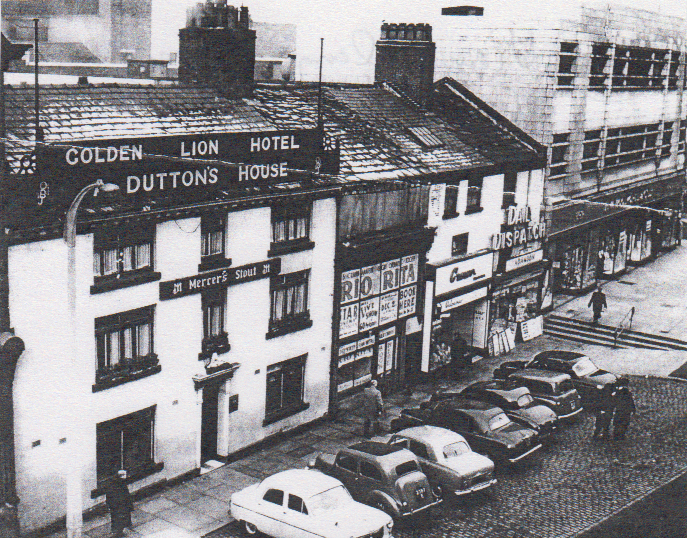
View along lower Church Street in 1958
Just off the picture to the left was Hilton’s Shoe Shop on the site of Thomas Hart’s warehouse. In the forefront is the Golden Lion Hotel, just before it closed, and the site along with the next two buildings was replaced by Arndale House and another shop linking to Woolworths. All these buildings in the view were eventually cleared to make way for the new shopping centre and market.
The Golden Lion Inn;
The Inn dated back to the 18th century, and, its original address was 24, Church Street. In 1810, the landlord was John Hargreaves; at this point the inn had stables, a brew house and other outbuildings. In 1824, the landlord was Joseph Duxbury. From 1824, it was recorded the inn acted as a posting house with the “Royal Union” coach from Blackburn to Liverpool, and, all parts to the North, leaving Mr. Duxbury’s Golden Lion Inn every day. The arrangements were as follows: 1. Tuesday and Friday mornings at 4.30am, the coach would leave for corn merchants etc. 2. Monday, Wednesday, Thursday and Saturday mornings at 6.45 am. Passengers could book at the Inn for Preston, Garstang, Lancaster, Burton, Kendal, Shap, Penrith and Carlisle where it arrived at 10 pm and then proceeded, next morning, to Annan, Dumfries, Glasgow and Edinburgh. Mr. Duxbury also offered reduced prices for return journeys, and, it would appear, he had established a “Pirate” coach to take customers from already established posting houses at the Old Bull, The Hotel, The Bay Horse and the New Inn. This often led to friction between the various post houses and breakneck races between the rival coaches and inevitable accidents. When customers were scarce rather than proceed with empty seats, proprietors would offer seats for free and even stand them a drink as an added inducement! However, for many years, the Golden Lion yard was a depot for local stage-wagons or land-carriers. The large courtyard behind the inn had ample stable accommodation. In1852, the landlord was Thomas Kenyon and he was followed by, Robert Riding, better known as “Cock Robin”, a noted sportsman. The Golden Lion was noted for its excellent “home-brewed ale” and its cellars were extensively stocked. However, due to the inn’s low-lying location, it was subject to flooding from the nearby River Blakewater which occurred at frequent intervals, the worst being, in 1792, when the Great Flood affected hundreds of buildings in the town centre. In November 1901, the flood was recorded at a depth of three feet six inches in nearby (aptly named) Water Street, and, the landlord Mr. Alec Forbes, saw his beer barrels floating down street. In the age before television, cinema and a variety of instant message applications, we often forget that inns such as the Golden Lion were at the centre of social life where people could hear the latest news, await the next post-coach, discuss urgent political issues and whisper current scandal.
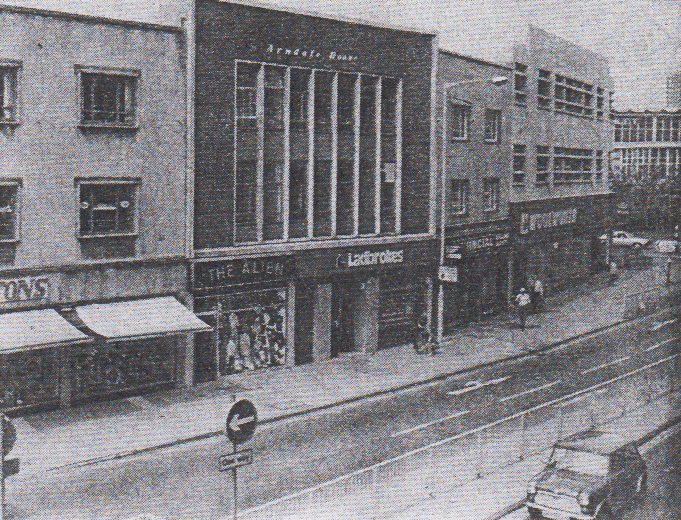
View of Hiltons, Arndale House, another shop outlet and Woolworths in the mid 1960s
before they were cleared later for the new market and shopping mall
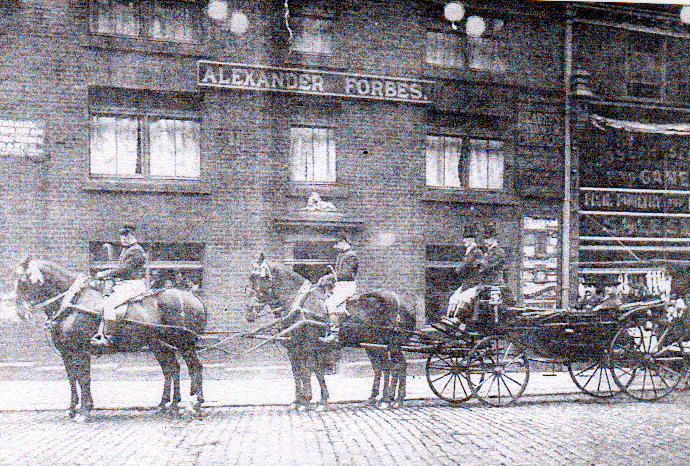
View of the front of the Golden Lion Inn when Alex Forbes was the landlord in the late 1890s with a fancy
carriage, footmen and two out-riders on the four lead horses carrying dignitaries
Originally, to the right of the Golden Lion was the shop of J.W. Astley bookseller and binder, followed by John McKean a brazier, Susannah Brown milliner, then William Aspinall Attorney, and finally, the Georgian mansion of Thomas Dugdale, the Surgeon, standing on the corner of what was then Woolworth's.
The 1958 picture displayed earlier shows a theatre booking office displaying the next performance of Blackburn Amateur Light Operatic Society's, "Rio Rita" and the Star Cinema's offerings in Little Harwood. Next door is the Crown Paints and decorating store, followed by a newsagents selling the daily Dispatch in front of which are a line-up of classic 1950's cars parked in a cobbled area including Ford's, Vauxhall's and Austin with steps leading up to Woolworth's.
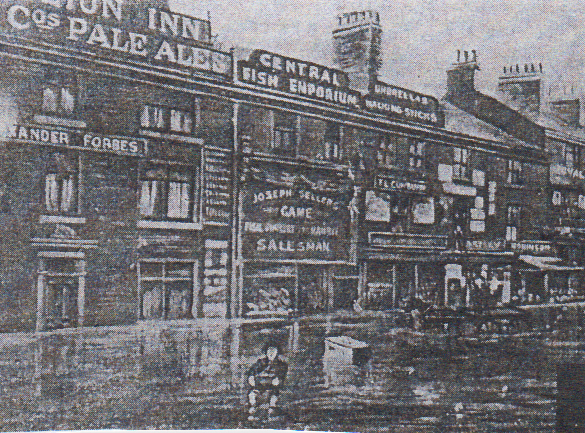
An artist’s impression of the great flood in November 1901 outside lower Church Street properties including floating debris
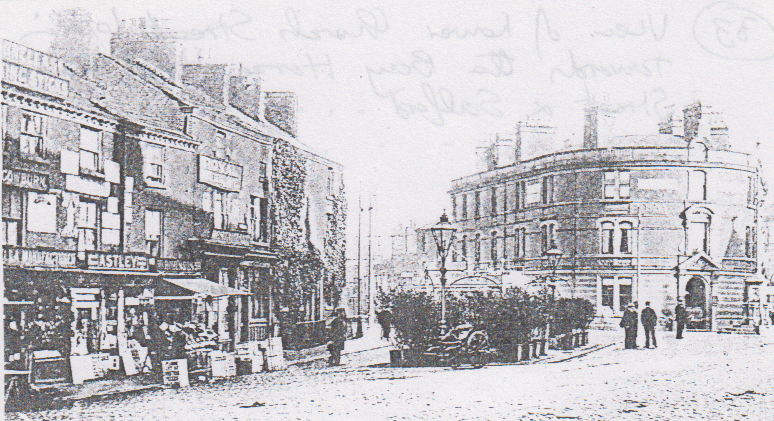
View of lower Church Street looking towards the Bay Horse Hotel, Water Street and Salford
which shows the properties, original public toilets (underground) surrounded by plants
and an original lamp standard around the late 1890s
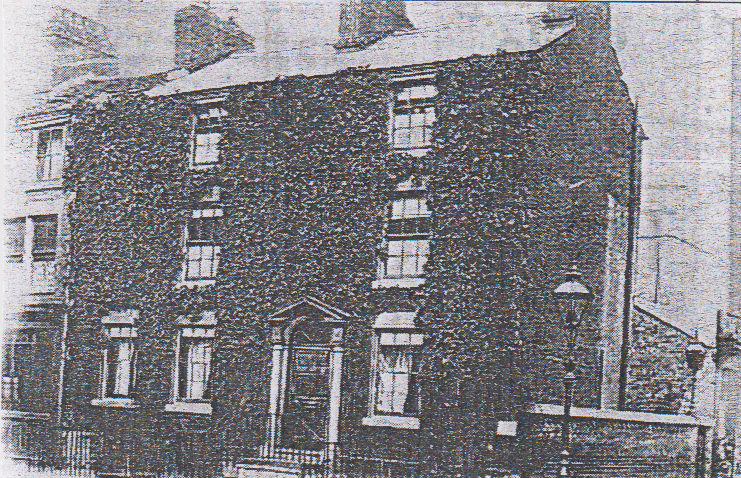
View of the Georgian mansion called Ivy House where Woolworths was eventually built on the corner with Ainsworth Street in 1888.
For many years, it was the surgery for Doctor J. Forrest and Doctor W.R. Pollard, then Doctor Thomas Dugdale.
By 1920, the building and shops next door were demolished to create a store called Hepworth, next door to Arndale House,
which changed ownership becoming Blackburn Corporation Transport Office which was later removed to create Woolworth’s Store
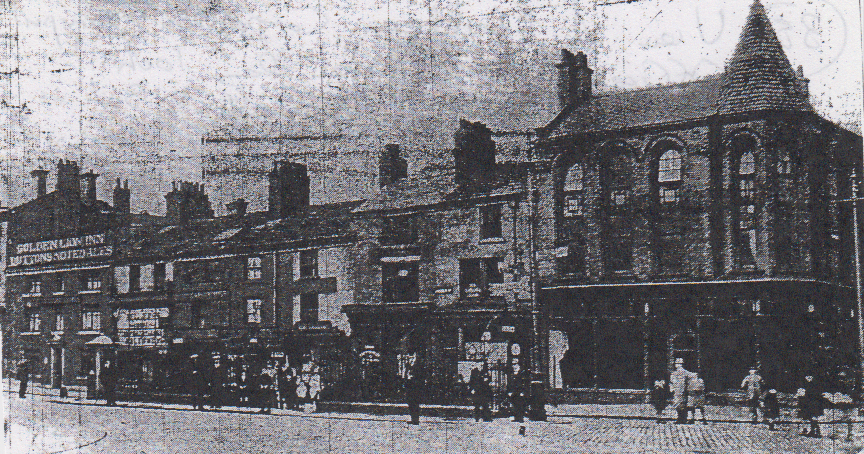
View of Blackburn Corporation Transport Offices in1925 when they took it over from Messrs. J. Hepworth and Sons Ltd., Clothiers.
It was used as an administration office by the Tramways Department
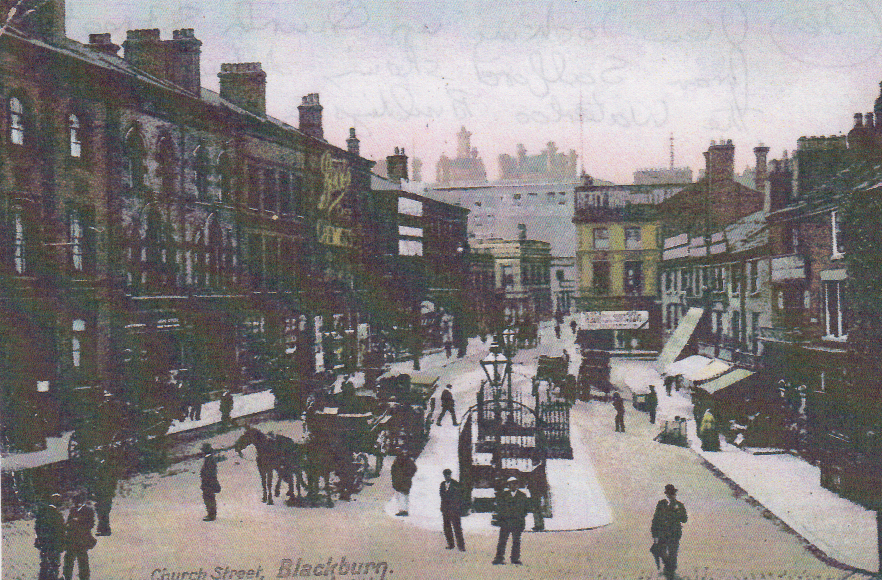
View looking up Church Street from Salford showing detail up to the Waterloo Buildings in the 1890s
Article compiled from a variety of resources held by Blackburn Central Library and Mike Sumner's own personal Local History Archive. December 2020.

